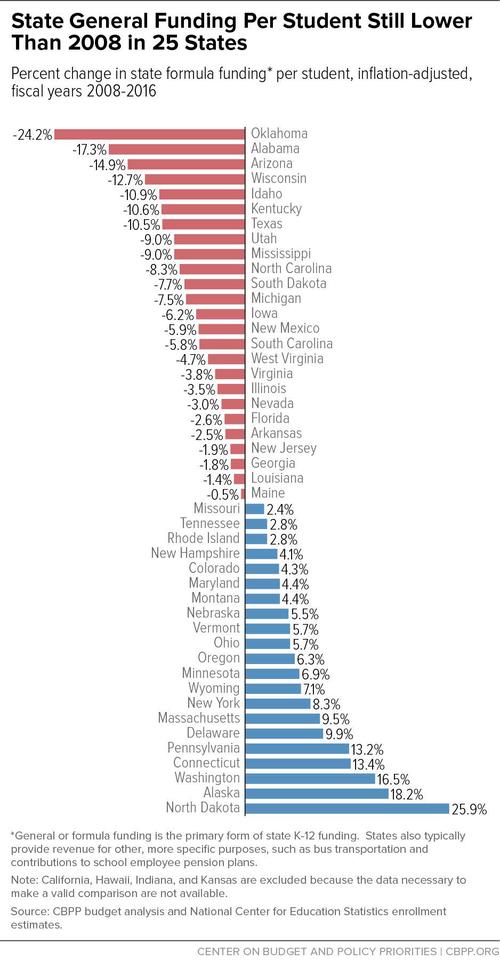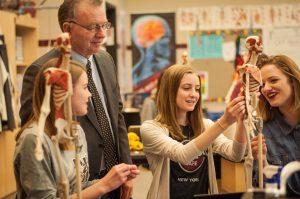Blogrige
The Official Baldrige Blog

Public schools across the country are facing significant challenges. Dr. Lisa Muller, assistant superintendent for Baldrige Award recipient Jenks Public Schools, says schools are dealing with an increase in student needs, while at the same time, managing declining revenues and attempting to prepare students for the demands of life in the 21st century.
“Students in public schools increasingly come to us facing challenges with poverty and other societal issues or needing support for English language development or learning challenges,” said Muller. “Effectively meeting the needs of this more diverse student population requires resources. However, the ‘Great Recession’ affected funding for school districts across the country. And despite a recovering economy, funding for public education remains below 2008 levels in half of our states.” The state of Oklahoma, home to Jenks Public Schools, leads this list of the 25 states where state general funding per student is still lower than it was in the year 2008, with a 24.2% decrease to state formula funding between 2008 and 2016.
According to Muller, “Increased student needs and decreased resources make the third challenge an even greater one—how do schools effectively equip students with the knowledge and skills they will need to be successful citizens in our 21st-century world? Schools must think beyond the traditional curriculum to help foster innovation and creativity in our students.”
Muller will be addressing this question and more in her presentation “How Baldrige Has Helped Address Challenges in Education” at the 2016 Baldrige regional conference in Dallas, Texas, on September 22.
I had the pleasure of a virtual interview with her to learn more about how Baldrige resources have helped.
Can you give us a sense of what your presentation will cover?
Our focus on continuous improvement and use of the Baldrige Criteria have helped Jenks Public Schools address challenges in multiple ways. In my presentation, I’ll focus on how implementation of the Baldrige model helped the district develop a student learning culture, encouraged a systems approach, and promoted process management across district school sites and departments.
One piece of the systems approach that occurred after our receipt of the Baldrige Award in 2005 was the development of the district’s core competencies. This concept was not in the Baldrige Criteria at the time of our award application, but we continue to use the criteria to drive continuous improvement efforts in the district. When the concept of core competencies was introduced, we conducted a process to identify our own. This process resulted in three core competencies: Excellence in the 5 “As”: Academics, Activities, the Arts, Attitude, and Athletics; Focus on Fiscal Stability; and Vision for Tomorrow. During difficult economic times, asking how various economic decisions will affect our ability to maintain and strengthen our core competencies has allowed the district to address our challenges with a systems focus.
What are your top tips for using Baldrige resources to support education?
In talking to other education organizations, I find that many see Baldrige as something that is more applicable to the operational side of their organization than it is to the instructional side. We have found quality principles and tools to be very applicable to improving teaching and learning, as well as to streamlining our operational processes.
Once you have decided to move forward with using Baldrige, be sure you truly view this as a journey rather than a destination. The work is very valuable to organizational effectiveness, but it is not fast! Jenks Public Schools dates the official “beginning” of its continuous improvement journey to 1995. Receiving the Baldrige Award in 2005 is now the midpoint of our efforts, and we still have many areas in which to learn and grow.
Because continuous improvement is a way of thinking and hopefully something that will become part of your organizational culture and not an initiative or program, my last tip is to resist “naming it” and instead just “do it.” Jenks Public Schools began working on continuous improvement prior to education organizations being eligible for the Baldrige Award, so we began that work under the umbrella of Total Quality Education (TQE) rather than as a Baldrige initiative. Some members of our organization were resistant to the changes brought on by the implementation of TQE and quality principles and stated that they were opposed to TQE. Once we shifted our language to speaking about continuous improvement and the desire always to be better tomorrow than we are today, much of that resistance went away. After all, it’s very difficult to say, “I’m opposed to continuous improvement. I’m as good now as I ever want to be!”
What else might participants learn at your conference session?
Our organization continues to use Baldrige to drive the continuous improvement efforts in the district under the leadership of the Continuous Improvement Leadership Team (CILT). This cross-functional team is responsible for overseeing the Baldrige category team work in the district and identifying district-wide goals for continuous improvement. In recent years, examples of these goals include improving the teacher onboarding process in an effort to decrease teacher turnover, identifying ways to increase community engagement and ensure the passage of bond issues to support capital improvements, and ensuring that our teaching and learning processes support and foster innovation and creativity.
What are a few key reasons that organizations in your sector can benefit from using the Baldrige Excellence Framework (Education) and its Criteria?
The Baldrige Excellence Framework helps schools and districts look at improvement efforts in a systematic, thorough way. Too often, school reform efforts come from outside the organization, but the Baldrige Excellence Framework promotes self-assessment and the identification and development of practices that uniquely address your organizational context. The framework provides a proven set of criteria that can be used to drive improvement and also encourage education organizations to reach out within our own sector, as well as to organizations in other sectors, in order to identify performance exemplars.
Holding your organization up against world-class standards helps frame the areas worthy of celebration, as well as highlight opportunities for improvement. When education organizations take on this type of continuous improvement work, it benefits not only themselves but also their students and the community as a whole.
Note: Lisa Muller will be speaking at the Baldrige regional conference in Dallas on September 22—along with many other representatives of Baldrige Award recipients in Dallas and Chicago (on September 8). You can access the full schedules and register from links on our website.
About the author
Related Posts
Comments
- Reply







